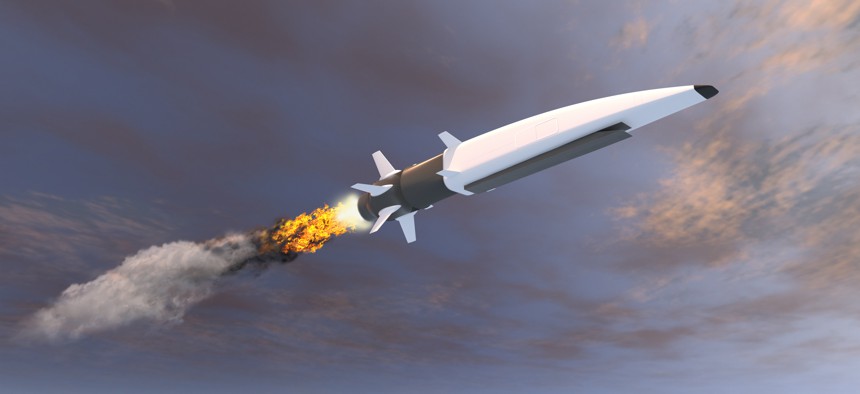
Artist's conception of a hypersonic missile. estt / Getty
Defense Business Brief: Biden moves to boost hypersonic weapons industrial base; Air Force orders new radar planes; Raytheon to build new missile warning satellites; and more.
President Joe Biden has authorized use of the Defense Production Act to “rebuild and expand” America’s hypersonic industrial base.
“Ensuring a robust, resilient, and competitive domestic defense industrial base that has the capability, capacity, and workforce to meet the hypersonic warfighting mission is essential to our national security,” Biden wrote in a March 1 memo to Defense Secretary Lloyd Austin.
Hypersonic weapons can travel at five times the speed of sound and can maneuver, making them difficult to track and intercept. Russia and China have been aggressively pursuing hypersonic weapon technology.
In the United States, the Air Force, Army, and Navy are all developing hypersonic weapons. The Pentagon said it would use the new authorities “to strategically accelerate the transition of operational prototypes and advanced manufacturing technologies across the spectrum of air-breathing engines and advanced avionics position, navigation, and timing (PNT) systems.”
"We are pleased and excited that the president is allowing us the opportunity to act on behalf of the nation to accelerate the advancement of hypersonics capabilities in the United States,” said Anthony Di Stasio, director of the Pentagon’s Manufacturing Capability Expansion and Investment Prioritization office. “These investments will lead to new training and job opportunities for American citizens in facilities across the country."
Meanwhile, in Congress, lawmakers have stood up the Hypersonics Caucus for the current legislative session. The group, the focus of which is “to promote the utilization of hypersonic weapons,” is co-chaired by Reps. Jim Banks, R-Ind., Doug Lamborn, R-Colo., and Salud Carbajal, D-Calif.
“Since we launched the first-ever House Hypersonics Caucus in March of 2021, our hypersonic capabilities have become even more critical to America’s national security,” Banks said. “As our adversaries rapidly grow their hypersonic arsenal, we need to support the defense industrial base’s investments in offensive and defensive hypersonic weapons.”
Other members of the panel include: Reps. Robert Aderholt, R-Ala., Michael Walz, R-Fla., Jerry Carl, R-Ala., Scott DesJarlais, R-Tenn., Joe Wilson, R-S.C., Sara Jacobs, D-Calif., Donald Norcross, D-N.J., and Michael Turner, R-Ohio.
Welcome
You’ve reached the Defense Business Brief by Marcus Weisgerber. Send along your tips and feedback to mweisgerber@defenseone.com or @MarcusReports. Check out the Defense Business Brief archive here, and tell your friends to subscribe!
The U.S. Army awarded prototyping contracts to AeroVironment, Griffon Aerospace, Northrop Grumman, Sierra Nevada, and Textron Systems for the Future Tactical Unmanned Aircraft System Increment 2. The program, known as FTUAS, “is the Army’s premier Vertical Take-Off and Landing Unmanned Aircraft modernization effort.” It seeks to develop drones that are rapidly deployable and can fly without using runways.
“When fielded, the FTUAS [drones] will provide a distinct tactical advantage over current systems due to increased maneuverability through VTOL, improved command and control supported by the On-the-Move (OTM) capability, a reduced transportation and logistics footprint, as well as significantly improved survivability due to reduced noise signature,” the Army said.
Rocketmaker United Launch Alliance, a joint venture of defense giants Lockheed Martin and Boeing, is for sale, Ars Technica reports. For years, the company’s Atlas and Delta rockets were the Pentagon’s primary source for launching satellites. Now Elon Musk’s SpaceX is a major player in national security satellites launches, and a host of startups or involved in military launches as well.
Raytheon Technologies received a $250 million Space Development Agency contract to build missile warning and tracking satellites. The satellites are part of a constellation being built to track “advanced missile threats, including hypersonic missile systems,” Raytheon said in a statement.
The U.S. Air Force awarded Boeing a much-anticipated $1.2 billion contract to begin work on new E-7A radar planes. The E-7 will replace dated E-3 AWACS aircraft. "This contract award is a critical step in ensuring that the department continues delivering battle-space awareness and management capabilities to U.S. warfighters, allies, and partners for the next several decades,” Andrew Hunter, assistant secretary of the Air Force for acquisition, technology and logistics, said in a statement. “The E-7A will enable greater airborne battlespace awareness through its precise, real-time air picture and will be able to control and direct individual aircraft under a wide range of environmental and operational conditions." The Air Force plans to buy 26 E-7s, which are based on the Boeing 737 airliner. The first aircraft is expected to enter service in 2027.
Making Moves
- Boeing named Howard McKenzie, the top engineer at Boeing's commercial airplanes unit, its chief engineer, succeeding Greg Hyslop, who is retiring after 41 years with the company.
- Mercury Systems named Christine Fox Harbison executive vice president and chief growth officer. She joins Mercury from Northrop Grumman, where she was vice president and general manager of its Combat Systems and Mission Readiness division.




